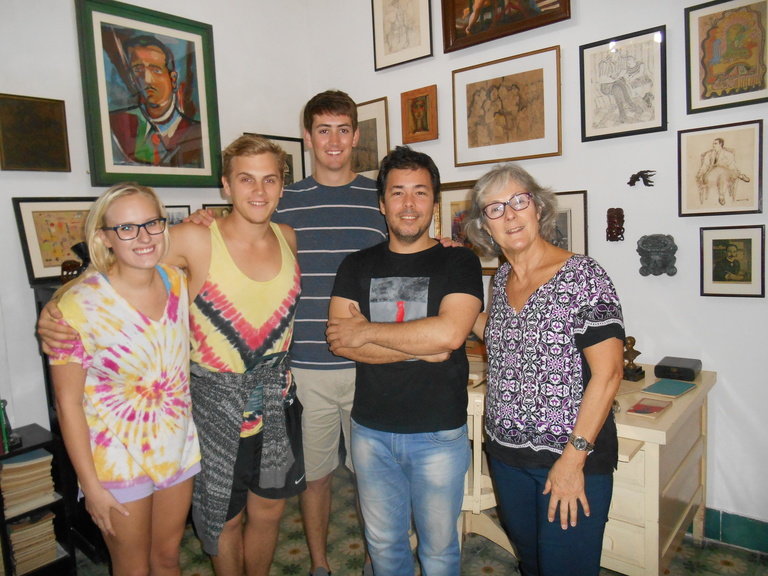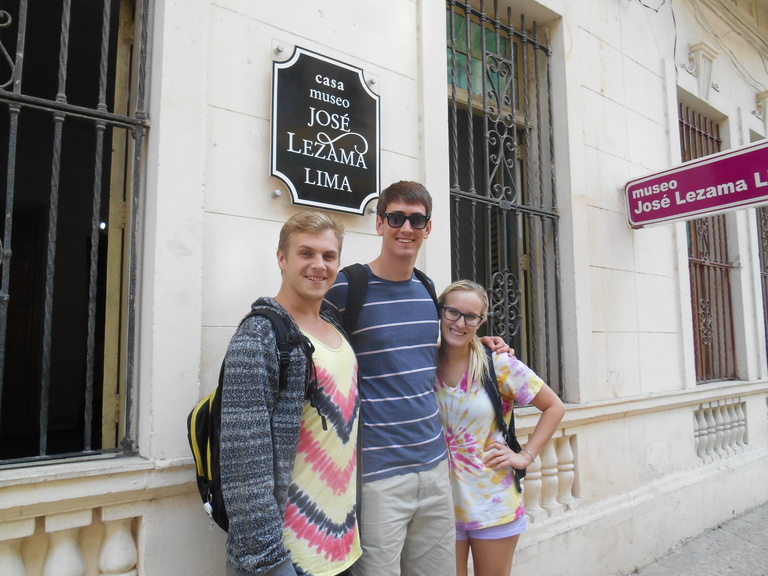By Adriana Méndez Rodenas, professor in the UI Department of Spanish and Portuguese
A group of about 20 students arrived at the Aeropuerto Internacional José Martí in Havana close to midnight on Sunday, December 28th. That very next morning, classes started for the January, 2015 USAC Havana program. Despite the late arrival and few hours of sleep, students were eager to climb up the marble staircase at Casa Africa in Old Havana for the first day of class.
As a visiting professor, I, too, felt the rush of excitement that comes from that first meeting with students. Only this was a very different classroom setting: our classes were held on the top floor of the Casa Africa, a cultural organization dedicated to Afro-Cuban culture, its rich imagery, languages, and rituals.

On the USAC Cuba program, courses are taught by faculty and instructors from both the University of Havana and Universidad Nacional de Heredia, with expertise in ethnology, Caribbean history, theater, cinema and politics.
Filled with the ethnographic collection of noted Cuban anthropologist Fernando Ortiz – known for his seminal works on Afro-Cuban music, dance, and ritual published during the Cuban Republic (1930s-1950s) – the Casa Africa was a veritable museum of Afro-Cuban lore, filled with exhibits of the different nations commingling in Cuban soil over more than four centuries of the slave trade. The swaying blue skirts of Yemayá, goddess of the sea, the vibrant red of the virile god of thunder Changó, and the iron ax of corpulent Oggún who presides over war invoked the powerful orishas of santería – a syncretic religion from Nigeria which blends African deities with Catholic saints. Other exhibits featured the ngangas or ceremonial offerings of palo monte, a set of practices transplanted to Cuba from the Congo.
The next week we set out to discover Havana, as the topic of our course was Havana in Cuban literature and art. We read tales of foreign travelers who captured the sights and sounds of a vibrant port city, the cross-roads of commerce between Spain and the New World during the long colonial period (1492-1895). We visited the Palacio de los Capitanes Generales at the Plaza de Armas, the spiritual heart of Havana, now converted into a museum of the city, with galleries showcasing colonial history, the war of 1895, and the transition to Independence in 1902.
Three Iowa students climbed the gracious quitrín or house-drawn carriage typical of Havana’s Romantic era, when ladies of the aristocracy paraded for all to see through cobble-stoned streets and paseos, under the sure guidance of the calesero, or black domestic slave dressed in the particular European style – high hat, white gloves, regal bearing. Cubans’ long road to Independence was displayed with portraits of créole patriarchs, the flags under which the mambí (Cuban rebel) army fought, and the memorable day when, after the American occupation, the U.S. flag was lowered and the brilliant lone star of Cuba rose over the rooftop of la Cabaña fortress. These exhibits gave students a first-hand view into the island’s complex history.

"Later in the week, to complement the memorable sketches of Havana written by José Lezama Lima, the Cuban Proust, we took a local almendrón, a taxi for Cubans only which takes the peso or national currency, down the stately Prado Boulevard to Trocadero street."
No trip to Cuba is complete without a visit to Varadero, dubbed “the most beautiful beach in the world.” Iowa students and their classmates from Nevada and other institutions tested this claim by dipping into aquamarine waters, playing volleyball in the sand, and holding silent tanning competitions. Since January 2nd was a holiday in Cuba, instead of the usual class, we took the classroom to the streets, or rather, the ferry, crossing over the bay to reach the town of Regla, an Afro-Cuban community known for its long-standing devotion to santería.
After a brief visit to the local church, our class stopped at the municipal museum in Regla, as we were accompanied by Alina García, museum specialist at the Humboldt House in Old Havana (which we had previously visited), and her husband, Eloy. Amidst display cases featuring the ever-present orishas, Eloy treated us to an impromptu lecture about santería practices and beliefs. The historical section of the Regla museum also showcased the students, housewives, and ordinary citizens who collaborated in the underground movement against dictator Fulgencio Batista during the late 1950s. Since many of these young men and women would have been their same age, UI students had an emotive response, as if they were witnessing history first-hand.
Later in the week, to complement the memorable sketches of Havana written by José Lezama Lima, the Cuban Proust, we took a local almendrón, a taxi for Cubans only which takes the peso or national currency, down the stately Prado Boulevard to Trocadero street. There, Israel Díaz Mantilla, director of the house/museum José Lezama Lima greeted us and gave us a tour of the library and paintings collected by Lezama Lima over his long and productive literary career. Founder of the Orígenes journal and head of the avant-garde movement in Cuban literature, Lezama Lima lives on in the works of younger writers who see in him the essence of Cuban culture. After the tour and lecture, we sat down for a cup of that thick, aromatic cafecito which accompanies social exchanges across generations.
At the end of the course, we were fortunate to visit the Fundación Alejo Carpentier honoring another premier Cuban novelist. Located in a splendid colonial mansion, the house was the site of Explosion in a Cathedral (El Siglo de las Luces), a historical novel about the impact of the French Revolution in the 18th century Caribbean. After the visit, students walked the city to discover the mix of styles which, for Carpentier, is distinctive of Havana architecture.
On the last night, students, teachers, and the program director, Sebastián Bombi, gathered to celebrate at La Marina restaurant, close to the plaza San Francisco. Over mojitos, moros y cristianos (rice mixed with black beans), and other typically Cuban dishes, we reminisced about Havana, a city whose past is present in crumbling walls, meandering streets, and iron-wrought porches. The opportunity to teach about Havana in my native city was, for me, a belated home-coming.